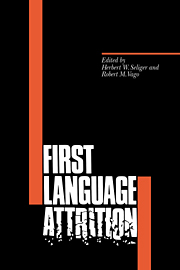Book contents
- Frontmatter
- Contents
- List of figures
- List of tables
- List of contributors
- Acknowledgment
- Part I Survey studies
- 1 The study of first language attrition: an overview
- 2 First language attrition and the parameter setting model
- 3 Recapitulation, regression, and language loss
- 4 First language loss in bilingual and polyglot aphasics
- 5 A crosslinguistic study of language contact and language attrition
- Part II Group studies
- Part III Case studies
- Index
5 - A crosslinguistic study of language contact and language attrition
Published online by Cambridge University Press: 14 January 2010
- Frontmatter
- Contents
- List of figures
- List of tables
- List of contributors
- Acknowledgment
- Part I Survey studies
- 1 The study of first language attrition: an overview
- 2 First language attrition and the parameter setting model
- 3 Recapitulation, regression, and language loss
- 4 First language loss in bilingual and polyglot aphasics
- 5 A crosslinguistic study of language contact and language attrition
- Part II Group studies
- Part III Case studies
- Index
Summary
Introduction
Most treatments of language contact presuppose one or more of the following conceptual models: (1) language contact as borrowing, or an additive model, such as Bloomfield (1933); (2) contact as opposing forces, or a resistance-to-mixture model, such as Sapir (1921); or (3) contact as selective blending, or the interference model, such as Weinreich (1953). Recent studies, however, provide empirical data which contradict the neat logic of these concepts. While it is clear that borrowing, interference, and autonomous change may and do occur in language contact situations, other linguistic effects are discernible as well. And these effects, in many cases, overshadow both borrowing and interference in shaping the language forms which result from the contact situation.
As Einar Haugen (1978: 37) points out:
As the learner builds new systems in the language he acquires, he dismantles and reorders the systems of the language he already knows.
It is this dismantling and reordering process which is the subject of this article. One of the best places to study this process is in the enclave speech community. Enclaves, for this purpose, are communities where speakers of one language, A, are surrounded and/or dominated by speakers of a different language, B, in a defined political or geographic area.
- Type
- Chapter
- Information
- First Language Attrition , pp. 67 - 84Publisher: Cambridge University PressPrint publication year: 1991
- 25
- Cited by

